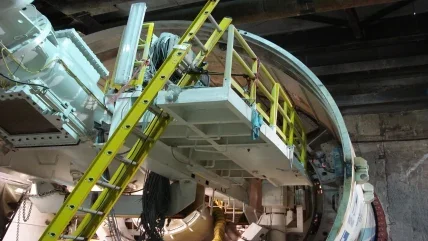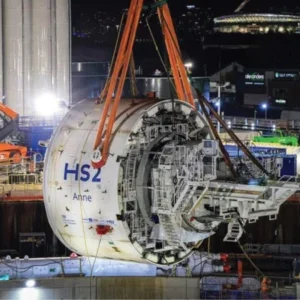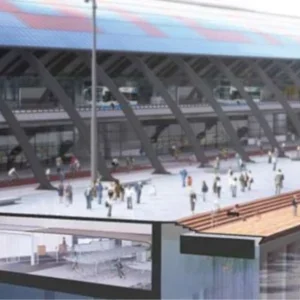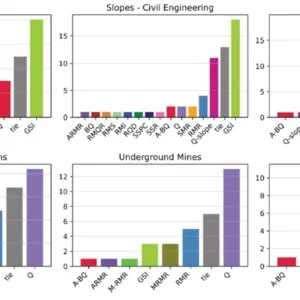
The emotional highlight of a tunnelling project is the final breakthrough. But work usually recommences immediately following breakthrough festivity as many tasks seamlessly follow until a project finally completed.
In many cases, equipment is bought back by the supplier. Processes such as inspections, buyback agreement, disassembly, return transport are essential to complete a project holistically. Afterwards, equipment in stock is available for re-use in the next project. Whether tunnel boring machines (TBMs) or additional equipment, these steps are crucial for the success of the entire project.
From manufacturer Herrenknecht’s point of view, the following article focuses in more detail on the best practice process for refurbishment of one of the most important of the additional equipment necessary on a jobsite performing slurry operated mechanised tunnelling – the Slurry Treatment Plant (STP).
REFURBISHED PRODUCTS IN THE CIRCULAR ECONOMY
The concept of a circular economy is based on the idea of creating a restorative and regenerative economic system that maximises the value and utility of products, components, and materials throughout their lifecycle. It involves a fundamental shift in our consumption patterns towards more sustainable practices, making it a crucial factor in achieving a sustainable future.
One of the most significant aspects of this approach is the refurbishment of products. By giving products a second life, we reduce waste and conserve resources. Refurbishment has benefits, both environmentally and economically. It enables the extension of the useful life of products, it reduces the need for raw materials and energy consumption, and it can provide more affordable options for consumers.
The economic benefits of buying refurbished products are significant. Firstly, refurbished products can be offered at an attractive budget compared to brandnew items. For example, a Herrenknecht Separations refurbished STP can be up to 30% cheaper than a brand new one. Additionally, buying refurbished products can help to support local economies and create jobs in the refurbishing industry as machines are often not transported back around the world or double handled to the OEM manufacturing location, as Herrenknecht globally runs workshops or partnerships.
This shows that embracing the circular economy through buying refurbished products not only benefits the environment but can also stimulate economic growth.
There are some challenges, though. They need to be addressed to fully realise the potential of refurbished products in the circular economy.
Quality assurance can be a challenge – since refurbished products already have been used, there is potential for unexpected issues to arise. However, sourcing high-quality products and using standardised refurbishment practices can help to address this challenge. In terms of the tunnelling industry, the ITATECH Guidelines from 2019 have addressed overall standards to follow as a minimum requirement.
Another challenge is customer perception, which may initially be that refurbished products could be inferior to new ones. Training and education may be needed to help consumers understand that refurbished products can be just as good as new ones, all while providing environmental benefits.
One final major barrier that refurbishing companies often face is regulatory, due to the lack of legislation on the right to repair. Many manufacturers design products in a way that makes it difficult for third-party repairers to access the necessary parts and information to fix them. This means that products that could be given a second life are instead discarded because they are otherwise made to be too costly or complicated to repair. Refurbishing products can require navigating complex regulations related to waste management, safety standards, and consumer protection.
However, the good news is that some progress is being made on this front. The EU has recently introduced the Right to Repair legislation, which requires manufacturers to make spare parts and repair information available to third-party repairers. Manufacturers will also have to design their products with repairability and refurbishment in mind, making it easier for customers selecting, using and trusting in refurbished components.
BEST PRACTICES FOR REFURBISHMENT IN THE CIRCULAR ECONOMY
When it comes to refurbishing products, there are several best practices to follow to ensure success. Herrenknecht’s network, as a pioneer in this field, brings experience of decades into account:
- Firstly, it is important to have a clear understanding of the refurbishing process, including any regulations or standards that must be met.
- Having a well-documented refurbishing and testing process with quality control measures in place is also crucial for ensuring the consistency and quality of refurbished products.
- Additionally, companies should prioritise the use of sustainable and eco-friendly materials and processes during the refurbishing process.
- Another best practice is to establish strong partnerships with suppliers and refurbishers who share the same values and commitment to the circular economy.
- Companies should consider offering warranties and other post-sale services to their customers to ensure customer satisfaction and continued loyalty.
- Finally, they should track and measure the environmental and economic impact of their refurbishment efforts to continuously improve and refine the processes.
SLURRY TREATMENT PLANTS (STP) AS A KEY TECHNOLOGY
Whenever tunnelling projects are realised with slurry shields or multi-mode TBMs, STPs are required to remove particles of soil from the slurry suspension and rejuvenate the slurry before it is pumped back to the tunnel face of the TBM. It is essential that the slurry remains in adequate quality ranges to maintain efficient excavation.
Slurry treatment has direct influence on the reliability and performance of a slurry shield tunnelling project. Inadequately dimensioned and designed STPs create bottlenecks for operation and so jeopardise time schedules and performance.
The STP, in this context, stands for the complete set-up and scope of the installation. The equipment assembly groups include the separation plant, centrifuge, filter press, mixing plant, storage tanks, conveyor belts, slurry management systems etc.
The separation process itself could be divided in two main sections separating the slurry suspension continuously from the loaded solid particles in the slurry circle. The active circuit (or primary separation) consists of the separation plants’ coarse-, desanding- and desilting cut stages, which are in continuous connection and communication through the Slurry Transport System (STS) with the TBM. The passive circuit (or secondary separation) operates in a by-pass to the active circuit and consists of ultra-fine particle separation equipment, like centrifuge or filter press.
SAFETY, PERFORMANCE AND COST ASPECTS OF STPS
Talking about STPs in relation to safety factors in tunnelling operations is all about slurry quality aspects, and to monitor and maintain the rheological conditions in the given target range.
A properly maintained slurry quality/drilling fluid has a direct influence on achieving balanced supporting pressure against water and soil pressure, and so ensure a stable working face condition in the working chamber of the TBM. The suspension used in slurry operated TBMs is in most cases a bentonite suspension generated, at the jobsite surface, by mixing bentonite powder with water.
Bentonite is a natural clay mineral out of the smectite clay group and shows a so-called thixotropic structure, which achieves a unique swelling behaviour that is used during tunnelling to build up a filter cake and stabilise the working face. Besides the stabilisation effect, the bentonite slurry is also used as a lubricant and transport medium for the solid load suspension, via the STS, out of the tunnel to the STP where it is recycled and pumped back to the TBM.
What starts with the detailed selection of TBM type should also be transferred to the STS and STP. The equipment should be considered as one system with clear interface and communication definitions. Therefore, it is recommended on each project to tender specifically the STP and its components in all details to match the TBM, and so enable maximum performance in tunnelling operations while satisfying the most demanding geological parameters. If not, a lack of performance in operation is predictable.
For contractors, it is highly recommended to consult with STP experts via experienced suppliers or independent consultants. With their training, experience and expertise, the STP experts can provide support to alleviate many challenges before they have a chance to occur. In many cases, these STP expertise should be used prior to the bidding process.
Planning billion-dollar projects in a desired range of costs is a huge challenge itself but making some profit is an even bigger one. Therefore, it is essential to know the influencing parameters on costs for a STP.
The project costs can be categorised into equipment, civil works, transportation, assembly, operation, and demobilisation. It is essential to calculate the expenses for each category accurately to establish a reliable budget. A precise budget can then be used to monitor the expenditures throughout the implementation of the project. It is also advisable to consider possible contingencies and allocate funds accordingly to avoid unbudgeted, unexpected expenses.
REFURBISHING STPs
The basic philosophy is to extend the useful life of the product. Refurbishment is predominantly considered to be a ‘full maintenance’ and ‘repair or replace defective functions or parts’ procedure, followed by a final functional test, including full test documentation. Herrenknecht has been refurbishing STPs since 2005, being one of the first companies on the market to offer this service.
Typical projects for refurbished products are projects without demanding, special challenges, employing machinery that successfully completed a comparable prior project. No upgrade is needed, except exceptionally.
After successful completion of a tunnelling project, systems or subassemblies are employed on a different project and to the original configuration of the equipment or with only minor modifications. To ensure economic benefits for both customers and the manufacturer, any necessary modifications need to be kept to a minimum, meaning that clever engineering of machinery – like with modular, container concepts – brings advantage.
GOING STEP-BY-STEP
Refurbishment is typically applicable for all projects as Herrenknecht’s STP components are standardised and mainly container modular. This allows equipment to be easily adapted or can be down- or up-upgraded for the next project.
Basically, the holistic refurbishment process can be separated into six steps in the workshop:
- Disassembly
- Cleaning
- Evaluation/ Inspection Process
- Reconditioning
- Workshop Re-Assembly
- Final Test and Quality Check
Disassembly
The first stage of the refurbishment process involves meticulously dismantling the components, ensuring that each part is correctly labeled and documented. This procedure necessitates a keen eye for detail and exactness to prevent any harm throughout the disassembly.
Cleaning
Once disassembled, it is necessary to thoroughly clean all items. This step involves removing any slurry residues, debris, or contaminants that may have accumulated over time during past projects. Proper cleaning ensures a good start for the refurbishment process and allows the next step.
Evaluation Process/Inspection
After cleaning, an evaluation and careful inspection of each component is conducted to determine its condition, identify any wear and tear or even damage, and assess if any components require repair or replacement.
Reconditioning
In this stage, any necessary repairs or replacements are made to components of the plant. This includes replacing worn parts and upgrading elements to improve the longevity and performance of the plant.
Workshop Re-assembly
Once all necessary repairs and replacements have been completed, the components are reassembled with careful attention to detail to ensure the correct alignment, setting and secure fastening of all components.
Final Test and Quality Check
The final stage entails performing a thorough examination and quality assurance evaluation of the renovated machinery. This encompasses confirming the operation of all constituent parts, testing the system in simulated operating situations, and verifying it adheres to the necessary performance benchmarks. At Herrenknecht, a full workshop assembly with water test-run and workshop acceptance for the main equipment is elementary to fulfill the requirements and expectations of our customers.
WHEN IS IT NEEDED?
STPs are often subjected to harsh operating conditions, leading to the deterioration of equipment and processes.
Aging infrastructure can result in leaks, corrosion, and reduced performance. Refurbishment helps address these issues by replacing or repairing damaged components, ensuring the plant operates again at its full potential.
Secondly, regulatory standards for STPs are continuously evolving, like for TBMs, to promote environmental sustainability and safety. Refurbishment allows plant owners to upgrade their facilities to meet these changing standards, ensuring compliance and avoiding penalties.
Last, but not least, refurbishment provides an opportunity to optimise the design and layout of STPs, leading to improved operational efficiency. Upgrading equipment, implementing automation systems, and optimising processes can result in reduced energy consumption, increased flow rate and enhanced overall performance.
ADVANTAGES: SUSTAINABILITY, COSTS AND SCHEDULE
Due to the global need of sustainability, it becomes more and more important to exhaust the life cycle of products to the maximum. For this reason, project owners are also placing increasing importance on being offered refurbished plants, so they can equip their jobsite as resource-saving as possible. So, refurbishment of STPs and other jobsite installations are a big step into the future of sustainable jobsites.
Refurbishment not only brings environmental advantages, it also brings a clear economic advantage for customers, project owners and suppliers. The supplier saves costs because refurbishment is significantly cheaper than manufacturing a new plant. Due to the lower costs for the supplier, the plant can be offered to the customer/project owner at a more favourable price, so that all parties involved have a cost advantage as a result.
Nowadays, time plays an exceedingly important role during tunnelling. Strict adherence to time schedules is necessary to avoid jeopardising an entire project. As a result, it is crucial to minimise the time until the plant is ready for operation. The refurbishment process provides a clear time advantage compared to manufacturing a new facility.
OUTLOOK
An STP is a key element in the overall slurry operated tunnelling process with regard to safety, performance and costs. Increasing stringent environmental regulations mean that the performance of STPs is becoming more important with respect to sustainability..
Challenging ground conditions, increasing regulations, tighter schedules and performance growth will increase and influence demands on STPs. Therefore, it becomes increasingly important to refurbish used plants for sustainability, cost efficiency as well as time management benefits.
This paper highlights several clear benefits of STP refurbishment in these fields, making it a significant advantage for a comprehensive tunnelling process. Herrenknecht adapted its processes to this market trend to meet customers’ and its own aspirations for more sustainable tunnelling.
There are already several success stories in our tunnel business of those who have embraced refurbishment and the circular economy. It’s a win-win for the environment and the economy. Ultimately, by embracing the circular economy and incorporating refurbished products into our purchases, we can work towards a more sustainable world for generations to come.






